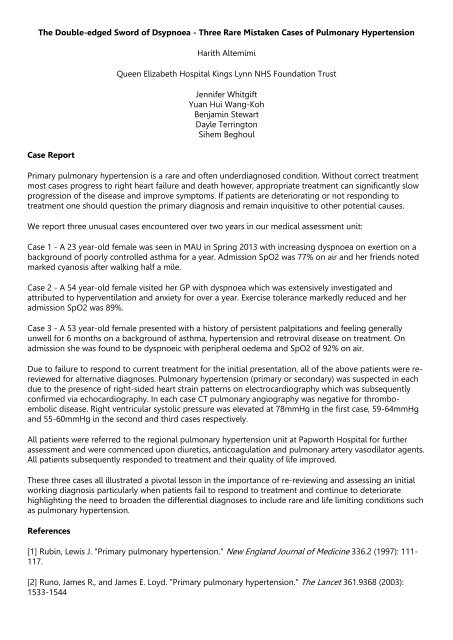Case Report ABSTRACTS
Case-Report-Abstracts
Case-Report-Abstracts
You also want an ePaper? Increase the reach of your titles
YUMPU automatically turns print PDFs into web optimized ePapers that Google loves.
The Double-edged Sword of Dsypnoea - Three Rare Mistaken <strong>Case</strong>s of Pulmonary Hypertension<br />
<strong>Case</strong> <strong>Report</strong><br />
Harith Altemimi<br />
Queen Elizabeth Hospital Kings Lynn NHS Foundation Trust<br />
Jennifer Whitgift<br />
Yuan Hui Wang-Koh<br />
Benjamin Stewart<br />
Dayle Terrington<br />
Sihem Beghoul<br />
Primary pulmonary hypertension is a rare and often underdiagnosed condition. Without correct treatment<br />
most cases progress to right heart failure and death however, appropriate treatment can significantly slow<br />
progression of the disease and improve symptoms. If patients are deteriorating or not responding to<br />
treatment one should question the primary diagnosis and remain inquisitive to other potential causes.<br />
We report three unusual cases encountered over two years in our medical assessment unit:<br />
<strong>Case</strong> 1 - A 23 year-old female was seen in MAU in Spring 2013 with increasing dyspnoea on exertion on a<br />
background of poorly controlled asthma for a year. Admission SpO2 was 77% on air and her friends noted<br />
marked cyanosis after walking half a mile.<br />
<strong>Case</strong> 2 - A 54 year-old female visited her GP with dyspnoea which was extensively investigated and<br />
attributed to hyperventilation and anxiety for over a year. Exercise tolerance markedly reduced and her<br />
admission SpO2 was 89%.<br />
<strong>Case</strong> 3 - A 53 year-old female presented with a history of persistent palpitations and feeling generally<br />
unwell for 6 months on a background of asthma, hypertension and retroviral disease on treatment. On<br />
admission she was found to be dyspnoeic with peripheral oedema and SpO2 of 92% on air.<br />
Due to failure to respond to current treatment for the initial presentation, all of the above patients were rereviewed<br />
for alternative diagnoses. Pulmonary hypertension (primary or secondary) was suspected in each<br />
due to the presence of right-sided heart strain patterns on electrocardiography which was subsequently<br />
confirmed via echocardiography. In each case CT pulmonary angiography was negative for thromboembolic<br />
disease. Right ventricular systolic pressure was elevated at 78mmHg in the first case, 59-64mmHg<br />
and 55-60mmHg in the second and third cases respectively.<br />
All patients were referred to the regional pulmonary hypertension unit at Papworth Hospital for further<br />
assessment and were commenced upon diuretics, anticoagulation and pulmonary artery vasodilator agents.<br />
All patients subsequently responded to treatment and their quality of life improved.<br />
These three cases all illustrated a pivotal lesson in the importance of re-reviewing and assessing an initial<br />
working diagnosis particularly when patients fail to respond to treatment and continue to deteriorate<br />
highlighting the need to broaden the differential diagnoses to include rare and life limiting conditions such<br />
as pulmonary hypertension.<br />
References<br />
[1] Rubin, Lewis J. "Primary pulmonary hypertension." New England Journal of Medicine 336.2 (1997): 111-<br />
117.<br />
[2] Runo, James R., and James E. Loyd. "Primary pulmonary hypertension." The Lancet 361.9368 (2003):<br />
1533-1544




